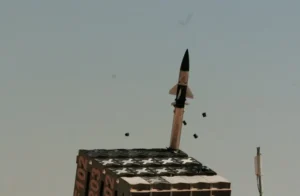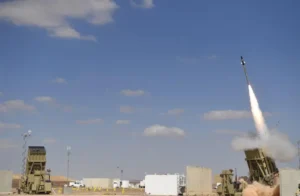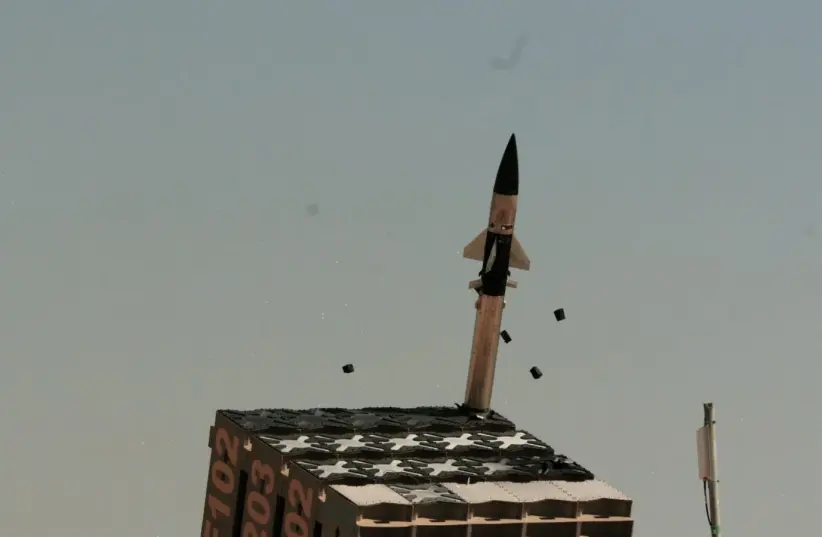The MRIC prototype is one of the systems developed to address an emerging capability gap for the USMC and uses Israeli missile defense components.

The US Marine Corps carried out a series of tests using its Medium-Range Intercept Capability (MRIC) prototype with components from Israel’s Iron Dome missile defense system.
The MRIC uses the Corps’ Ground/Air Task-Oriented Radar (G/ATOR) and Common Aviation Command and Control System (CAC2S) and incorporates the Iron Dome’s Tamir interceptor and launcher “to create an air defense system tailored to existing USMC assets and expeditionary requirements,” read a statement by Israel’s Defense Ministry.
“Once again, the Iron Dome has proven its effectiveness and operational capabilities in combat scenarios,” said Brig.-Gen. (Res.) Pinhas Yungman, Executive Vice President and General Manager of the RAFAEL Air & Missile Defense Division.
“As part of the US Army’s operational training, American troops operated the system which functioned at optimal effectiveness against a variety of threats and intercepted targets from different ranges,” he added.
During the live-fire tests at the White Sands Missile Range in New Mexico on June 30, the prototype tracked each target and passed them through the CAC2S to the Iron Dome components. MRIC successfully hit several simultaneously-launched cruise missile representative targets from different directions and in different trajectories.
“At its peak, numerous in-air targets, each with its own unique flight trajectory and velocity, surrounded the MRIC prototype. Upon firing, MRIC successfully hit each target using the Tamir missile.”
US Marine Corps
“At its peak, numerous in-air targets, each with its own unique flight trajectory and velocity, surrounded the MRIC prototype. Upon firing, MRIC successfully hit each target using the Tamir missile,” read a statement released by the Marine Corps.
The live-fire test follows a previous live-fire test in December when multiple targets were launched in sequence, with the MRIC intercepting each target before the next one was fired. During this event, multiple targets were launched simultaneously.

According to the Marine Corps statement, the live-fire test was “designed to validate the primary subsystems’ integrations and the system’s overall capability to provide critical information to senior Marine Corps leadership as they decide the path forward for the MRIC prototype.”
Addressing an emerging Marine Corps gap
The MRIC prototype is one of the systems developed in order to address an emerging capability gap for the USMC.
Maj. James Slocum, MRIC Medium Range Intercept Capability team lead at PEO Land Systems, said that the program takes proven components and integrates them into a system that is compatible with Marine Corps architecture in order to rapidly develop a relevant capability.
“As long-range cruise missiles and anti-air weapons systems begin to get better and better, air supremacy is not something we can take for granted. We must be able to counter these types of capabilities,” he said.
“This demonstration proves that we do now have a relevant capability,” said Don Kelley, program manager for GBAD at PEO Land Systems, immediately following the successful test.
Head of the Defense Ministry’s Israel Missile Defense Organization Moshe Patel said that the test “has proven” that the Tamir interceptor and ground components of the Iron Dome can be “integrated quickly and efficiently in any relevant defense architecture and intercept various aerial threats successfully in complex and advanced scenarios.”
In use since 2011, the Iron Dome, which is designed to shoot down short-range rockets, is an integral component of Israel’s multi-layered defense array. The Tamir interceptor is capable of intercepting cruise missiles, unmanned aerial systems, rockets, artillery and mortars.
The prime contractor for the development and production of the Iron Dome is Rafael Advanced Systems who adapted the system to USMC requirements and associated testing support. The MMR radar is developed by ELTA, a subsidiary of Israel Aerospace Industries (IAI), and the command and control system (BMC), is developed by mPrest.
The fully mobile system carries 10 kg. of explosives and can intercept an incoming projectile from four to 70 km. away. It is able to calculate when rockets will land in open areas, choosing not to intercept them, or toward civilian centers.
The other defense layers include the Arrow-2 and Arrow-3 systems that intercept ballistic missiles outside of the Earth’s atmosphere while David’s Sling missile defense system which is designed to intercept tactical ballistic missiles and medium- to long-range rockets, as well as cruise missiles fired from ranges of 40 km. to 300 km.

